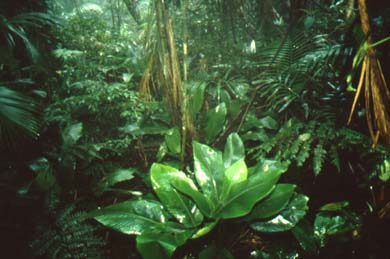- Atlantic Forest
- Biodiversity of the Tropical Forests
- Biological Diversity
- Caatinga: Biodiversity Under Threat
- Cerrado: Biodiversity Under Threat
- Extinction of Species
- New Species of Primates Discovered in Brazil
- Paraná Pines on the Verge of Extinction
- The Destruction of Tropical Forests
A traveller crossing the 5,000 kilometres separating Alaska from the Atlantic coast of Canada will find only a small diversity of life in the enormous swathes of temperate forest through which he will pass. If he is observant he will notice at least 200 species of plants with around just ten varieties per hectare. If that same person were to walk through just a few kilometres of tropical forest, he would be taken aback by the radical change in the exuberance and diversity of the species. There are more than 600 species per hectare, with almost 400 different types of trees. Of the 250,000 species of higher plants known to science, 90,000 are to be found in tropical Latin America, 30,000 in the tropical regions of Africa and 35,000 in those of Asia.
There are several types of tropical forest: rain forests with high levels of rainfall throughout the year; semi-deciduous forests with one or two dry seasons each year; and deciduous forests that are subject to extended periods of drought during the year. Their distribution is restricted to the region between the tropics and only four countries in the world – Brazil, Indonesia, Zaire and Peru – contain more than half these formations.
Only 7% of the land surface is covered by tropical forest, representing around half the total of the species on the planet. This fantastic diversity of life provides these ecosystems with potential resources for use by man that was never previously imagined.
In the field of medicine, the Amazon Forest alone contains 1,300 different plants that have an acknowledged therapeutic value. In the tropical forests of Asia where civilization is more developed, this figure is at least ten times greater. At the present time, 25% of medicaments used by man in developed countries contain elements extracted from tropical forests – and that percentage is growing steadily.
Recent research has shown that health problems that were previously untreatable can now be helped using ingredients taken from tropical forests. At least 1,400 plants containing anti-cancer substances have been catalogued. A small plant from the forests of Madagascar, threatened with extinction, has increased the chances of survival for children suffering from leukaemia from 10% (1960) to 90% (1980).


